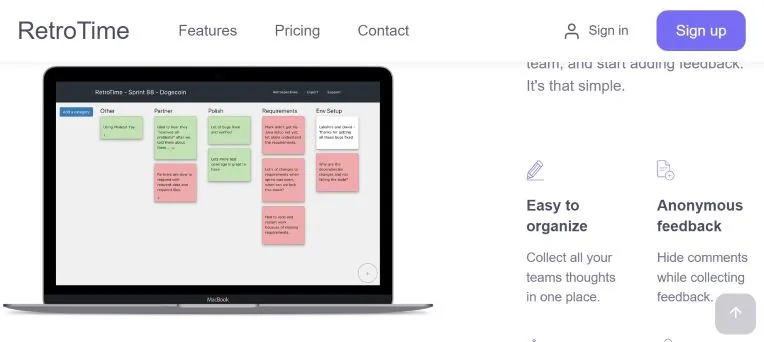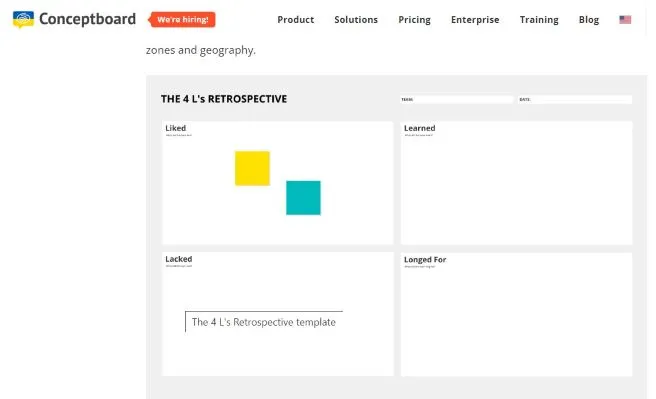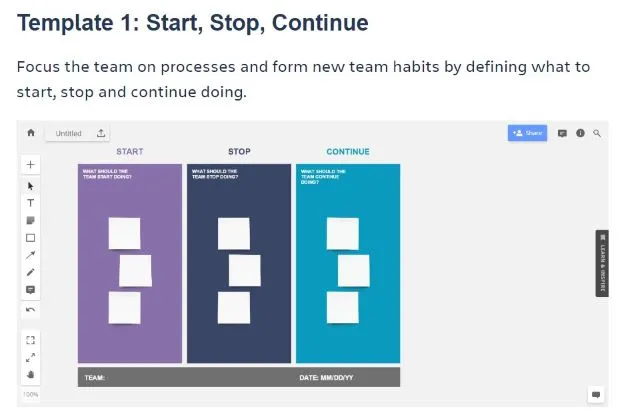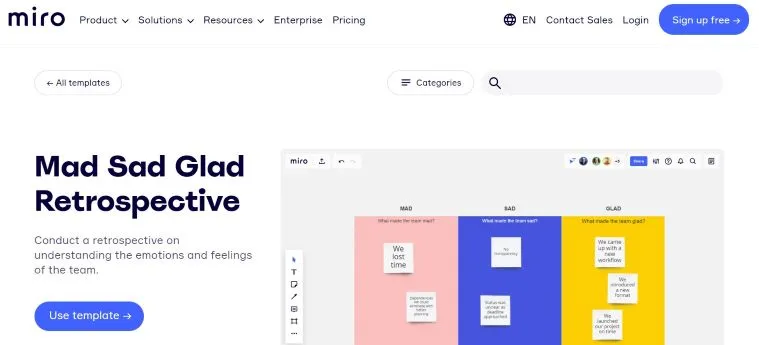Efficiency, smoothness, harmony, and conflict-free cooperation between Scrum team members and Scrum teams is a goal that a Sprint Retrospective allows you to achieve.
The overriding idea of the Scrum framework is improvement; mainly, it's about self-improvement based on acquired experience during a project, not just in relation to a whole team but also to each individual Scrum team member.
Scrum is about reflecting on successes, failures and self-reflection to see worthwhile elements that can be improved. It's a moment when a Scrum team reflects on everything that happened in the previous sprint.
Scrum is a tool that allows you to handle problems. The goal is not only to increase productivity, efficiency, and harmony but to obtain the highest quality and value of the digital product.
Scrum is often associated with development teams, but thanks to its universality, it can be used in design teams.
Or to be precise, in all teams in which, the effect of work depends on the work of individual team members and the cooperation between them, both internally and between teams.
Scrum is a framework for project management that describes meetings, tools, and roles.
Their combination and synchronization enable teams to structure work and manage projects and tasks.
Sprint retrospective is a term that has to appear when talking about Scrum. It is an integral and vital element of it.
What is a Sprint retrospective? What is it all about?
Why is it such an essential element, and what benefits it provides to an organization that doesn't underestimate the Sprint retrospective?
Besides announcing more detailed answers to the above questions, it's worth noting that the value of a team can be measured according to the ability to continuously develop and improve.
However, development and improvement won't be possible without a moment of self-reflection of the team, during which it summarizes its actions, considers the work it accomplished, and what is left to do.
This moment is the Sprint retrospective about which you will read in this article.
We cordially invite you to read it!
Sprint retrospective — what is it?
According to the research results published in the article "Do team and individual debriefs enhance performance? A meta-analysis," teams that regularly and diligently perform Sprint retrospectives are about 25% more effective.

This 25% difference is not a coincidence, and surely it's not a cosmetic difference that can be ignored without the feeling of losing a chance or opportunity.
The more so that the essence of agile methodologies is a quick and effective adaptation to changes.
The adaptability of teams is possible through a frequent and regular feedback loop. And that's what (more or less) the Scrum/Sprint retrospective is all about.
Let us remind you once again — the Sprint retrospective is about self-improvement, summarizing, analyzing, looking critically, and spotting problems.
Or metaphorically speaking, the Sprint retrospective is about asking proper questions and formulating adequate answers.
The Sprint retrospective is the last event of a Sprint cycle and a moment that aims to develop means and methods that will allow you to achieve better results and improve processes, activities, and tools.
The basic premise of the Sprint retrospective reads as follows: the workflow can always be improved. That's why it's worth taking the time and energy to summarize everything at the end of a sprint (before the sprint review meeting).
Entering a new sprint without finding the time and willingness to perform a retrospective indicates that the team will repeat problems.
Thanks to the retrospective, every subsequent sprint — in theory and practice — will be more:
- Productive
- Smooth
- Conflict-free
- Efficient
- Rational
- Up-to-date
- Punctual
- Harmonious
- Pleasant.
It's worth remembering that the retrospective is a relatively cheap, quick, and easy-to-implement "method" that aims to increase efficiency and improve work atmosphere, relationships, and communication.
The Sprint retrospective meeting is organized by a Scrum Master just after the completion of a sprint. Its purpose is to:
- Bring together all important stakeholders
- Collect feedback from the team (observations, opinions, evaluations, comments, positive and negative suggestions)
- Compile data
- Discuss data and feedback
- Prepare a plan for work optimization that will be implemented in the upcoming sprint.
It's worth emphasizing here that disadvantages are as crucial as advantages.
This is because the goal is full self-awareness of the teams — their strong sides and those that need correction and improvement.
Hence, the Sprint retrospective meetings should answer the following:
- What went well and won't require improvement?
- What went relatively well but will require improvement?
- What went badly, why did it happen, and how to fix it?
- Which of the problems are the most pressing and require changing in the next sprint?
- Which of the problems aren't so pressing that it's necessary to solve them as soon as possible?
Prioritizing problems is extremely important because, as you might easily guess, not all issues can be fixed, improved, and solved immediately.
Thus, ranking is essential.
The Sprint retrospective is usually performed in a defined unit of time, which is determined by the Scrum Master, following the principle of proportions. The longer the sprint, the longer the retrospective.
Naturally, the length of the sprint results in more data, processes, actions, interactions, and effects to summarize, evaluate and discuss.
The time for the summary and correction should be optimal.
It can't be too short because there is a risk of omitting problems or treating them superficially. In turn, a too-long retrospective can result in discouragement.
A significant element is also the atmosphere during a meeting.
All stakeholders should feel safe. The Sprint retrospective isn't a tool for evaluation or discipline but a time for insight, understanding, and adaptation.
It serves to support, motivate, engage, and integrate.

According to the authors of the article "Agile Retrospectives," published on the Atlassian blog:
"The retrospective should be a positive, energizing experience for your team. It helps team members share important feedback, let go of frustrations, and work together to come up with solutions."
Furthermore, the Sprint retrospective is also beneficial for facilitators who, thanks to it, have an opportunity to better and more profoundly understand how the team:
- Works
- What challenges it faces
- Reacts to challenges, successes, failures, and motivators
- Cooperates internally and externally
- Communicates
- Sees its potential, resources
- Sets goals and divides them into tasks.
Usually, a Facilitator is a Scrum Master or a Product Owner. A best practice that is simultaneously recommended is to rotate this role throughout the team.
In a purely practical sense, lists of issues that "worked" and "require improvement" can be created in a dedicated tool (Atlassian Confluence, Retrium, MindMeister, RetroTime) or in a more traditional way with sticky notes.
Lists should be ordered according to the abovementioned rule of relevance, importance, and immediacy.
When analyzing individual items from the list, it's worth remembering to pay less attention to people and more to results.

An essential element of the Sprint retrospective is an Action Plan that should be implemented consistently by a precisely defined "owner."
Sprint retrospective — benefits
The abovementioned benefits of a 25% increase in productivity can translate, as the authors of the article "To 10x Your Profits Start With Retrospectives" assure, into a multiplication of profits.
Whether it will be a tenfold or some other kind of increase depends on many factors regarding structure and market, but one thing is sure, these benefits are real and possible to achieve.
What other benefits can be gained by an organization which uses agile methodologies and treats the Sprint retrospective as an important tool for work organization, team, and project management and for obtaining market advantage?
It's worth remembering that what influences the team also affects the digital product it works on.

Tools, contexts, processes, and methods are reflected in the product, not just in its perfection but also in the time needed for its creation.
Sprint retrospectives performed at the end of every sprint provide the following:
- Control over problems
- Management of problems
- Continuous awareness of issues
- Self-awareness that translates into certainty and motivation
- Definition of goals and means
- Awareness of project advancement and its complexity
- Shared perspective for all team members.
The primary benefits of the Sprint retrospective include the following:
- Increased involvement of team members in the project
- Better clarity and transparency regarding processes, roles, decisions, goals, actions, and desirable methods
- More trust toward the team and team members toward each other
- Safety of communicating problems
- Better communication and mutual understanding
- Improved work atmosphere
- Reduced stress, tensions, misunderstandings, and unclear situations
- Minimized risk of failure regarding various scopes and horizons
- Accumulated profits and reduced costs
- Aggregated knowledge, experience, and know-how
- Exchange of information between stakeholders who don't have such opportunities on a daily basis
- Control over time, budget, and processes
- Risk management.
Sprint retrospectives in every project, especially in a big and complex one, play the role of milestones.
How to perform a retrospective?
The Sprint retrospective may seem like a tedious, routine, and for some, even unnecessary activity that adds little to the organization's operations.
It's a harmful approach that's not worth following.

Of course, it's true that the effectiveness of the Sprint retrospective largely depends on the attitude of a Scrum Master, team members, and other stakeholders.
How it is carried out is also crucial, including whether any techniques are used to streamline the event and support the process of collecting and evaluating feedback.
To fulfill its role, the Sprint retrospective can't be treated as:
- Casual meetings — breaks from work
- Necessity — as a meeting that needs to happen, but it's not worth engaging in it
- Form of exchanging resentments, accusations
- Meeting for scolding, judging, holding accountable, or competing.
Retrospectives should be performed in line with the adopted agenda based on a predictable, repetitive structure that should include the following:
- The opening of the retrospective — defining the goals
- Collecting data
- Aggregating observations, comments, and suggestions
- Planning actions
- The closing of the retrospective.
There are many techniques and methods for performing Sprint retrospectives, and their common denominator is making the meeting more attractive and effective and activating participants by increasing their engagement.
The most commonly used methods during Sprint retrospectives include the following:
- Start, Stop, Continue Retrospective — in which every team member determines what the team started doing, what it should stop doing, and what it should continue to do.
- Surprised Worried Inspired Retrospective — allows you to simultaneously focus on the future and past and determine surprising, worrisome, or inspiring issues.
- Hands on Deck Retrospective — in which the team takes on the role of the ship's crew and tries to discover what parts of the work of a given role are liked and which are disliked and burdensome.
- Hero's Journey Retrospective — it enables you to determine the team's future, set long-term goals and increase loyalty and group integrity.
- Original 4 Retrospective — helps determine and understand the strengths and weaknesses of team members and the team as a whole.
- Hopes and Fears Retrospective — allows team members to share their hopes and fears before the next sprint.
- Speed Car Retrospective — enables team members to focus on elements that will allow the team to work faster and more efficiently in the future.
- SWOT Retrospective — helps indicate strengths and weaknesses of the team and determine opportunities and threats.
- Hot Air Balloon Retrospective — points out things that slow the team's work and those that speed it up.
- T-Shirt Sizing Scale — helps you plan and estimate the efficiency and allows you to track how much time and work it will take to complete a given task.
- Glad Sad Mad Retrospective — allows you to improve the team's morale and indicate what made them glad, sad, and mad during a sprint.
- Mountain Climber Retrospective — enables you to change the perspective, look at the project from a distance, and define the various aspects of the project as climbing.
- Three Little Pigs Retrospective — lets you see the project as one of the three houses from the story "The Three Little Pigs" and thus determine what is solid and what can collapse.
- Working & Stuck — helps you determine what works (even if not perfectly) and doesn't work in the project.
The effectiveness of the Sprint retrospective doesn't only depend on a specific technique but also an approach.

The attitude that accompanies team members during tasks and the retrospective is crucial.
Especially during the retrospective, you should:
- Maintain a certain margin of leniency and tolerance — in other words, you shouldn't be too critical and strict.
- Optimally approach the number of things that need changing — it's better to change one or two things satisfactorily than introduce many changes simultaneously because it creates chaos and increases stress.
- Be aware that the motivation must be dosed throughout the project and that it is an exhaustible and hardly renewable resource.
- Strive to solve problems and conflicts in an unbiased way devoid of personal motivations.
- Maintain mutual respect, understanding, and trust.
- Focus on cooperation, eliminate rivalry and competition
- Celebrate failures — mistakes are a source of knowledge and are very enlightening.
Sprint retrospective. Summary
- The Sprint retrospective aims to increase productivity, smoothness, harmony, and conflict-free cooperation among team members and between teams.
- Scrum is often associated with development teams, but thanks to its universality, it can be used in design teams.
- Development and self-improvement of teams require stopping and taking time to self-reflect.
- During the Sprint retrospective, the development team summarizes actions performed in the last sprint and thinks about the work it did and what is left to do.
- The adaptability of the entire team is possible with the use of regular feedback loops.
- The Sprint retrospective is a moment that aims to develop means and methods that will allow you to improve processes, activities, and tools.
- The workflow can always be better. That's why summarizing operations at the end of a sprint is worth the time and energy.
- The Sprint retrospective is usually performed in a defined unit of time, which is determined by the Scrum Master, following the principle of proportions.
- The Sprint retrospective isn't a tool for evaluation or discipline but a time for insight, understanding, and adaptation. It's a way to inspect activities and summarize the scrum team's work, prepare a plan of improvements and manage team members.
- The role of a Scrum Master is to prepare an Action Plan, an essential element of the Sprint retrospective.
- Sprint retrospectives play the role of milestones.
- The effectiveness of retrospectives (also in a daily scrum formula) largely depends on the attitude of all stakeholders.
- There are many techniques and methods for performing Sprint retrospectives, and their common denominator is making the meeting more attractive and effective.







